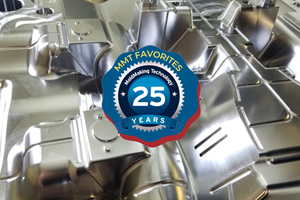Creating Constructive Change: Sales Applied
There are several shops that achieved their sales goals within the past year through a solid sales process and achievable goals.
In a perfect world mold manufacturers would have superstar sales reps, who bring in so much business that a backlog of almost a year exists; your margins would be huge; and, you would never have to know your banker’s name. In today’s economic times this may sound like a fantasy, but it’s not. There are several shops that achieved these goals within the past year through a solid sales process and achievable goals.
Example 1: One company recognized early that a change in attitude had to be instilled from the top to the bottom of its organization. First thing they did was stop wasting their time on deadbeat customers. They set solid criteria to be followed in order to be considered as one of their customers:
1. A customer had to pay them for their work on time.
2. Enough information was provided in a timely manner so as to be able to provide the best service to the customer.
3. The customer recognized the value-added components that the moldmaker did to make their relationship more profitable.
Once they set these standards, they started firing customers. This was a bold move when no one knew who would give them the next job, and there was no backlog or orders on the books. In six months, the shop was filled to capacity with work, and all at the margins they demanded.
Example 2: Another shop did set a standard for their customers, yet their sales were still stagnant. They were a small shop and used a sales representative who sold for many small-to medium-sized shops. This sales rep had the reputation for knowing everyone in the industry, and worked long hours. When they first started using this rep they landed a few jobs, but then things tapered off. After reviewing what could be wrong, it become apparent that the sales rep’s contacts were slowly retiring, and that he either had to find new contacts or they had to find a new rep. After a short discussion the rep decided to focus on selling just for this shop and find customers that fit their special niche. Sales soared, and once again they had a significant backlog.
Example 3: A small Midwestern shop that always prided itself as able to “Do Everything,” hit very bad times. They always had work, but never knew when the next project would arrive. Then the phone stopped ringing and the work was gone. They did not have a sales strategy or a salesperson. The owner did not panic. Instead he realized they needed a strategy and a focus on what they could do best. He then picked up the phone and started calling “new” companies. He was rejected time after time and couldn’t figure out why. One of his friends told him that his personality was not one for sales, and that maybe he should hire a salesman. At the same time a shop nearby closed its doors causing his phone to ring off the hook with guys looking for work. One particular guy was very persistent, so he was hired as a salesman. He started making cold calls and suddenly hit the right chord with customers. In a few short weeks, this shop had a backlog.
What can we learn from these shops? Every successful shop needs a sales strategy. It is okay to get rid of deadbeat customers and allow your competitors to have these accounts. You need to have a sales team who knows how to sell and who has the passion and drive to make cold calls. You need to constantly evaluate your sales process to fit the work that you do and establish a customer base that recognizes yours strength.
Related Content
Tackling a Mold Designer Shortage
Survey findings reveal a shortage of skilled mold designers and engineers in the moldmaking community, calling for intervention through educational programs and exploration of training alternatives while seeking input from those who have addressed the issue successfully.
Read MoreEditorial Guidelines: Editorial Advisory Board
The Editorial Advisory Board of MoldMaking Technology is made up of authorities with expertise within their respective business, industry, technology and profession. Their role is to advise on timely issues, trends, advances in the field, offer editorial thought and direction, review and comment on specific articles and generally act as a sounding board and a conscience for the publication.
Read MoreThink Safety: Eliminate Hazards Throughout the Shop
The tooling community is taking advantage of new products for safer mold shops and molding facilities.
Read MoreLeading Mold Manufacturers Share Best Practices for Improving Efficiency
Precise Tooling Solutions, X-Cell Tool and Mold, M&M Tool and Mold, Ameritech Die & Mold, and Cavalier Tool & Manufacturing, sit down for a fast-paced Q&A focused on strategies for improving efficiencies across their operations.
Read MoreRead Next
Reasons to Use Fiber Lasers for Mold Cleaning
Fiber lasers offer a simplicity, speed, control and portability, minimizing mold cleaning risks.
Read MoreAre You a Moldmaker Considering 3D Printing? Consider the 3D Printing Workshop at NPE2024
Presentations will cover 3D printing for mold tooling, material innovation, product development, bridge production and full-scale, high-volume additive manufacturing.
Read More

















